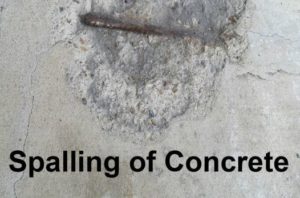Causes and Repair of Slab Concrete Spalling

What exactly is concrete spalling? Basically, it’s a breakaway concrete surface that affects a broad variety of concrete structures. This is a common problem encountered by old structures, especially warehouse-type ones where a continuous span of concrete exists and subjected to consistent heavy loads like the slab. Also is there a repair for concrete spalling ?
Concrete spalling is largely a cause of natural concrete deterioration, but more extreme causes such as carbonation and rebar corrosion results to a more extreme case of concrete spalling where the concrete surface breaks away entirely — leaving the rebars exposed.
Generally, it looks like a distinct patchy concrete surface that is entirely different from normal concrete scratches or abrasion, making it distinguishable among the others.
If you notice a distinct patchy concrete surface, you need to seek professional help. Because if left untreated, it might progress into a more severe problem such as big structural cracks and extreme rebar corrosion. It can also scar the aesthetic look of your property permanently if left untreated.
Causes of Concrete Spalling
- Improper construction joints, especially at slabs: These joints, if not levelled correctly, are usually where concrete spalling starts due to wear and tear. Consistent bumps from forklifts and materials slid through the floor, and foot traffic will eventually spall these joints. These joints should have adequate rebar dowels and joint sealants for protection.
- Overworking of overly wet concrete during finishing: Overworked concrete results in the aggregates settling down at the bottom layers. Meaning that the top layer of the concrete is devoid of aggregates, resulting to a mortar mixture that is prone to wear and tear.
- Excessive water bleeding during curing: Excessive water bleeding also results in the aggregates settling down at the bottom, leaving the top layer as a mortar mixture.
- Loss of bond between concrete and rebars: This happens when concrete is placed on top of excessively hot rebars during hot-weather concreting.
- Rebar corrosion: Corrosion of rebars produce ugly by-products that can crack the concrete, resulting to even more corrosion and concrete spalling.
- Inadequate depth of concrete cover: Inadequate depth of concrete cover on top of the rebars is considered a weak concrete that is prone to wear and tear, and shrinkage and plastic cracks.
- Freeze and thaw cycles: As water freezes inside the voids of the concrete, it expands and starts to put pressure on the concrete — cracking the top layers which then results to concrete spalling.
Repair Methodology of Slab Concrete Spalling
Since concrete spalling is a pretty common problem, many repair groups claim that they have the best repair strategy. The truth is some do, but mostly don’t. Concrete spalling may seem like a simple problem to deal with, but it’s more complicated than it looks.
We will be sharing with you our general work-flow methodology which varies depending on the spalling depth. What makes it effective is our emphasis to prep works, workmanship, and choice of materials.
Step 1: Mark a delimitation area around the spalled concrete. Usually a square shape mark.
Step 2: Remove loose pieces of concrete by chipping and find out the depth of spall.
- Spalled concrete is pretty loose and can be easily removed.
Step 3: Cut through the concrete using a concrete cutter along the delimitation line.
- Doing so prepares the area for a more efficient chipping works later on.
- It also prevents the crack from expanding to other sound concrete during chipping works.
Step 4: Chip-off concrete using chipping gun or jackhammer.
Step 5: Clean the area thoroughly and dampen the substrate with water.
Step 6: Apply structural epoxy to the substrate.
- Follow manufacturer’s recommendation.
Step 7: Prepare patching material.
- Follow manufacturer’s recommendations.
- Make sure that the compressive strength of the patching material is stronger than that of the slab.
Step 8: Patch up the area until a smooth finish is achieved.
- If depth of spall is less than 50 mm, use non-shrink structural mortar with structural epoxy.
- If depth of spall is between 50 and 100 mm, use non-shrink structural mortar without structural epoxy.
- If depth of spall is more than 100 mm, use concrete with small aggregates without structural epoxy.
Step 9: Finish the patching material using stainless steel trowel or power trowel if area is large.
Contact Us for More!
Dealing with such a problem may seem like a hard problem to solve alone, so let us have the pleasure of helping you out. Structural Builders has been repairing spalled concrete for many different clients for many years now and they couldn’t be any happier.
Affordable Structural Builders is a structural repair company based at Liverpool and our team of experts are more than willing to help you out!
